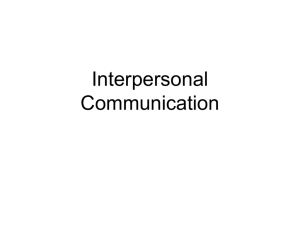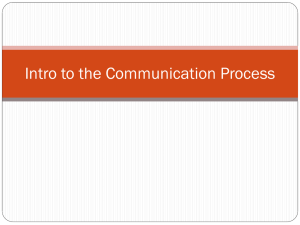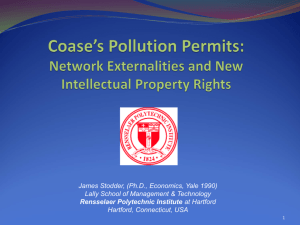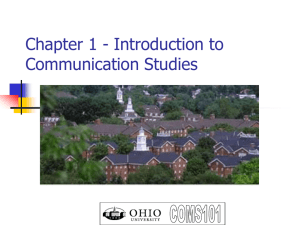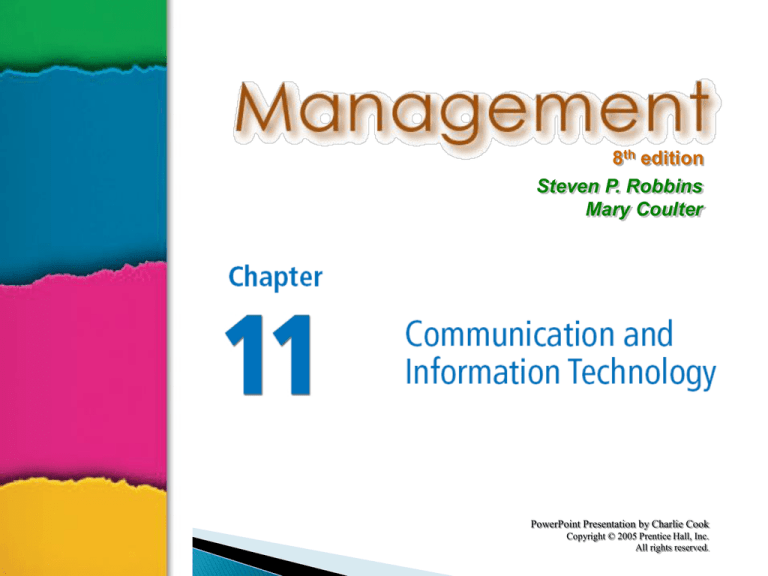
8th edition
Steven P. Robbins
Mary Coulter
PowerPoint Presentation by Charlie Cook
Copyright © 2005 Prentice Hall, Inc.
All rights reserved.
Understanding Communications
•Differentiate between interpersonal and organizational
communication.
•Discuss the functions of communication.
The Process of Interpersonal Communications
•Explain all the components of the communication
process.
•List the communication methods managers might use.
•Describe nonverbal communication and how it takes
place.
•Explain the barriers to effective interpersonal
communication and how to overcome them.
Copyright © 2005 Prentice Hall, Inc. All
rights reserved.
11–2
Organizational Communication
•Explain how communication can flow in an organization.
•Describe the three common communication networks.
•Discuss how managers should handle the grapevine.
Understanding Information Technology
•Describe how technology affects managerial
communication.
•Define e-mail, instant messaging, voice-mail, fax, EDI,
teleconferencing, videoconferencing, intranet, and
extranet.
•Explain how information technology affects
organizations.
Copyright © 2005 Prentice Hall, Inc. All
rights reserved.
11–3
Communication Issues in Today’s Organization
•Discuss how Internet employee gripe sites
affect communication.
•Explain how organizations can manage
knowledge.
•Explain why communicating with customers is
an important managerial issue.
•Explain how political correctness is affecting
communication.
Copyright © 2005 Prentice Hall, Inc. All
rights reserved.
11–4
Communication
◦ The transfer and understanding of
meaning.
Transfer means the message was
received in a form that can be interpreted
by the receiver.
If no information has been conveyed,
communication has not occurred
Understanding the message is not the
same as the receiver agreeing with the
message.
Copyright © 2005 Prentice Hall, Inc. All
rights reserved.
11–5
◦ Interpersonal Communication
Communication between two or
more people
◦ Organizational Communication
All the patterns, network, and
systems of communications
within an organization
Copyright © 2005 Prentice Hall, Inc. All
rights reserved.
11–6
Control
◦ Formal and informal communications act
to control individuals’ behaviors in
organizations.
Motivation
◦ Communications clarify for employees
what is to be done, how well they have
done it, and what can be done to improve
performance.
Copyright © 2005 Prentice Hall, Inc. All
rights reserved.
11–7
Emotional Expression
◦ Social interaction in the form of work
group communications provides a way for
employees to express themselves.
Information
◦ Individuals and work groups need
information to make decisions or to do
their work.
Copyright © 2005 Prentice Hall, Inc. All
rights reserved.
11–8
Elements
of the Process
message - expresses the purpose
of the communication. It can be
the written document, the oral
speech, and even the gestures and
facial expressions we use.
11-9
119
Elements of the Process
encoding - converting the message in
symbolic form
affected by the skills, attitudes, and
knowledge of the sender, and by the culture
of the organization.
A sender initiates a message by encoding a
thought.
• Four conditions influence the effectiveness of
that encoded messages: skills, attitudes,
knowledge of the sender, and the sociocultural
system.
• Example teaching at IUG.
•
11-10
1110
b.
Elements of the Process
channel - medium for conveying the
message
a.
Managers need to recognize that
certain channels are more appropriate for
certain messages.
A manager might want to use multiple
channels—this decreases the potential for
distortion.
11-11
1111
Elements of the Process
The receiver is the individual to whom the
message is directed.
a.The receiver must decode the message.
b.
Decoding accuracy is limited by the skills,
attitudes, knowledge of the receiver, and sociocultural system.
11-12
1112
•
Elements of the Process
The feedback loop\circle is the final link in the
communication process.
a.Feedback provides a check on whether
understanding has been achieved.
b.
Because feedback can be transmitted
along the same types of channels as the original
message, it faces the same potential for
distortion.
11-13
1113
Message
Medium
Encoding
Receiver
Decoding
Noise
Sender
Message
Feedback
11-14
1114
Message Encoding
◦ The effect of the skills, attitudes, and
knowledge of the sender on the process of
encoding the message
◦ The social-cultural system of the sender
The Message
◦ Symbols used to convey the message’s
meaning
◦ The content of the message itself
◦ The choice of message format
◦ Noise interfering with the message
11–15
Copyright © 2005 Prentice Hall, Inc. All rights reserved.
The Channel
◦ The sender’s choice of the appropriate channel or
multiple channels for conveying the message
Receiver
◦ The effect of skills, attitudes, and knowledge of the
receiver on the process of decoding the message
◦ The social-cultural system of the receiver
Feedback Loop/circle
◦ Communication channel distortions affecting the
return message from receiver to sender
Copyright © 2005 Prentice Hall, Inc. All
rights reserved.
11–16
•
•
1.
2.
3.
4.
Methods of Communicating
Interpersonally
a wide variety of communication
methods exist.
choice of a method should reflect:
the needs of the sender
the needs of the receiver
the attributes of the message
the attributes of the channel
11-17
1117
1. Feedback - how quickly can the receiver respond to the
message?
2. Complexity capacity - can the method effectively process
complex messages?
3. Breadth potential - how many different messages can be
transmitted using this method?
4. Confidentiality - can communicators be reasonably sure their
messages are received only by those intended?
5. Encoding ease - can sender easily and quickly use this
channel?
6. Decoding ease - can receiver easily and quickly decode
messages?
7. Time-space constraint - do senders and receivers need to
communicate at the same time and in the same space?
11-18
1118
1. Cost - how much does it cost to use this method?
2. Interpersonal warmth - how well does this method
convey interpersonal warmth?
3. Formality - does this method have the needed amount
of formality?
4. Scan ability - does this method allow the message to
be easily browsed or scanned for relevant
information?
5. Time of consumption - does sender or receiver
exercise the most control over when
the message is dealt with?
11-19
1119
Face-to-face
Telephone
Group meetings
Formal presentations
Memos
Traditional Mail
Fax machines
Employee publications
Bulletin boards
Audio- and videotapes
Hotlines
E-mail
Computer
conferencing
Voice mail
Teleconferences
Videoconferences
Copyright © 2005 Prentice Hall, Inc. All
rights reserved.
11–20
11-21
1121
•
Methods of Communicating Interpersonally (cont.)
nonverbal communication - communication without
words.
Sounds with specific meanings or warnings
Images that control or encourage
behaviors
Situational behaviors that convey
meanings
Clothing and physical surroundings that
imply status
11-22
1122
•
•
•
•
•
•
Methods of Communicating Interpersonally
(cont.)
Types of nonverbal communication
body language – gestures\signs, facial
expressions, and other body movements that
convey meaning
verbal intonation \tone- emphasis someone
gives to words or phrases that conveys
meaning
every oral communication is accompanied by a
nonverbal message.
It is not what you said, it is how you said it.
nonverbal component usually carries the
greatest impact
11-23
1123
11-24
1124
1.
2.
3.
4.
5.
Choose the right channel of communication for
the follows:
University would announce for new registration
system.
The ministry of higher education established
new fund to support students to pay fees.
Academic Affairs decided new examination
system. This is needed to be conveyed to
students.
A manager fired his employee because of low
performance and he needs to submit the
decision to the worker.
New restaurant was opened near be the IUG.
How to convey the message to customer.
1125
•
Filtering - the deliberate manipulation/handling
of information to make it appear more favorable
to the receiver.
• upward communication is condensed by senders
to avoid information overload by top-level
receivers.
• extent of filtering affected by:
• the number of vertical levels in the organization
• culture of the organization: the importance of
appearance.
• Selective Perception - is when people selectively
interpret what they see or hear on the basis of their
interests, background, experience, and attitudes.
11-26
1126
•
Emotions - interpretation of a message affected
by the way the receiver feels.
• extreme emotions likely to hinder effective
communication
•
•
It’s best to avoid reacting to a message when the receiver
is upset because he/she is not likely to be thinking
clearly.
Information Overload - information available
exceeds processing capacity. Such as 600 waiting email messages in the in box.
•
frequent complaint of executives.
a. Receivers tend to select out, ignore, pass over, or
forget information when they have too much information.
b. Or, receivers may put off further processing until the
overload situation is over—still ineffective
communication.
11-27
1127
•
•
Defensiveness - behaviors that result from
feeling threatened.
engaging in behaviors such as verbally
attacking others, making sarcastic remarks,
being overly judgmental, and questioning
others’ motives—happens when people feel
that they’re being threatened.
11-28
1128
•
•
•
Language - meaning of words differs among
people with diverse backgrounds.
a. Age, education, and cultural background can
influence language use and definition given to
words.
b. Jargon is specialized terminology or technical
language that members of a group use to
communicate among themselves.
National Culture - cultural values affect the way
people communicate. E.g., Arab versus USA.
individualism versus collectivism
11-29
1129
•
•
•
•
•
Use Feedback - ask a set of questions about a message
to determine whether it was understood as intended
ask receivers to restate the message in their own words
Simplify Language - tailor the language to the audience
for whom the message is intended.
jargon can facilitate understanding when used in
appropriate groups.
Listen Actively - listen for full meaning
a. Listening is an active search for meaning, whereas
hearing is passive.
b. Active listening is listening for full meaning without
making premature judgments or interpretations, and
demands total concentration.
c. Active listening is enhanced by developing
empathy\sympathy with the sender—placing yourself in
the sender’s position.
11-30
1130
Avoid interrupting
the speaker
Don’t overtalk
Avoid distracting/
Disturbing actions
Or gestures
Be empathetic\
kind
Active
Listening
Ask questions
Make eye
contact
Paraphrase/
rephrase
Exhibit affirmative
head nods and
appropriate
facial expressions
11-31
1131
• Constrain
Emotions - emotions
severely cloud and distort the
transference of meaning.
• refrain from communicating until one
regains her/his composure.
• Watch Nonverbal Cues \signalsactions should be aligned with words
• nonverbal message should reinforce
verbal message.
11-32
1132
•
•
•
•
Formal Communication
communication that follows the official chain of
command or is communication required to do
one’s job
It takes place within prescribed organizational work
arrangements.
Informal Communication
not defined by the organization’s structural
hierarchy.
It fulfills two purposes
1. permits employees to satisfy their needs
for social interaction
2. creates alternative, and frequently faster
and more efficient, channels of
communication
11-33
1133
U
p
w
a
r
d
Lateral
D
o
w
n
w
a
r
d
Copyright © 2005 Prentice Hall, Inc. All
rights reserved.
11–34
•
Downward - flows from a manager to
subordinates
• used to inform, direct, coordinate, and evaluate
employees
• Upward - flows from subordinates to managers
• keeps managers aware of employees’ feelings
• source for ideas on improving operations
• The amount of upward communication is
affected by the culture of the organization:
trust and empowerment increase upward flow
Mechanistic/use machines and authoritarian
environment decrease upward flow
11-35
1135
Lateral communication: takes place among
employees on the same organizational
level. Horizontal cross functional team.
• Diagonal - cuts across both work areas and
organizational levels
• benefits efficiency and speed.
• e-mail facilitates diagonal communication.
• Diagonal communication has the potential
to create problems if employees don’t keep
their managers informed.
•
11-36
1136
•
•
•
•
•
•
Organizational Communication Networks
combination of vertical and horizontal flows
into a variety of patterns.
Types of Networks
chain - communication flows according to the
formal chain of command, both direction.
wheel - flows between a clearly identifiable
and strong leader and others in a work group
or team. Leader serves as a hub through
whom all communication passes.
all-channel - flows freely among all members
of a work team.
No single network is best for all situations
11-37
1137
11-38
1138
•
•
•
•
Grapevine\gossip - an informal network that is
active in almost every organization.
Important source of information.
Identifies issues that employees consider
important and anxiety producing.
Can use the grapevine to disseminate
important information.
Rumors can never be eliminated entirely
a. The grapevine is active in almost every
organization. One survey reported that 75
percent of employees hear about matters first
through rumors on the grapevine.
b. The grapevine can act as both a filter and a
feedback mechanism.
11-39
1139
•
•
•
•
•
•
•
•
•
How Technology Affects Managerial Communication
Information technology has changed organizational
communication.
Disseminates more complete information.
Provides more opportunities for collaboration.
Employees are fully accessible.
Two developments in information technology seem to
be having the most significant impact: networked
computer systems and wireless capabilities.
First: Networked Computer Systems - linking computers
through compatible hardware and software.
Some of its communication applications are the follows:
e-mail - instantaneous transmission of written
messages.
It is fast and cheap and can be used to send the same
message to numerous people at the same time.
11-40
1140
Benefits of Information Technology (IT)
◦ Increased ability to monitor individual and team
performance
◦ Better decision making based on more complete
information
◦ More collaboration and
sharing of information
◦ Greater accessibility
to coworkers
Copyright © 2005 Prentice Hall, Inc. All
rights reserved.
11–41
Effect of Technology (cont.)
Networked Computer Systems - (cont.)
• instant messaging (IM) - interactive real-time
communication
• requires groups to be logged on the computer
network at the same time. E.g., communication
among friends on line.
• leaves network open to security breaches.
• IM software is currently incompatible\contrary
with important business applications software.
• voice-mail - digitizes a spoken message
• transmits message over the network.
• stores the message for later retrieval.
11-42
1142
•
•
•
•
Effect of Technology (cont.)
Networked Computer Systems (cont.)
Fax - allows transmission of documents containing
both text and graphics over ordinary telephone
lines
Electronic data interchange (EDI) - permits the
exchange of standard business transaction
documents. such as invoices or purchase orders,
using direct computer-to-computer networks.
Used with vendors, suppliers and consumers.
Teleconferencing - permits simultaneous
conferral\talking using telephone or e-mail group
communications software.
videoconferencing - participants can see each
other .
11-43
1143
•
•
•
•
•
Effect of Technology (cont.)
Networked Computer Systems (cont.)
Intranet - Internet technology that links organizational
employees.
Extranet - systems are organizational communication
networks that use Internet technology and allow
authorized users inside the organization to communicate
with certain outsiders such as customers and vendors.
Internet-based voice communication - allows users to
talk with each other. On Compaq web site, visitors can
click on an icon and speak live to a company
representative.
Second: Wireless Capabilities - depends on signals sent
through space without any physical connection
based on microwave signals, satellites, radio waves, or
infrared light rays
11-44
1144
Removes the constraints of time and distance
◦ Allows widely dispersed employees to work
together.
Provides for the sharing of information
Integrates decision making and work
◦ Increases effectiveness and efficiency.
◦ Provides more complete information and
participation for better decisions.
Creates problems of constant accessibility to
employees
◦ Blurs the line between work and personal lives.
Copyright © 2005 Prentice Hall, Inc. All
rights reserved.
11–45
Being connected versus being concerned
◦ Managing Internet gripe sites as a valuable resource
for unique insights into the organization.
Employee complaints (“hot-button” issues)
Customer complaints
◦ Responding to Internet gripe sites
Recognized them as a valuable source of information.
Post messages that clarify misinformation.
Take action to correct problems noted on the site.
Set up an internal gripe site.
Continue to monitor the public gripe site.
Copyright © 2005 Prentice Hall, Inc. All
rights reserved.
11–46
Managing the Organization’s Knowledge
Resources
◦ Build online information databases that employees
can access.
◦ Create “communities of practice” for groups of
people who share a concern, share expertise, and
interact with each other.
Copyright © 2005 Prentice Hall, Inc. All
rights reserved.
11–47
Communicating Effectively with Customers
◦ Recognize the three components of the customer
service delivery process:
The customer
The service organization
The service provider
◦ Develop a strong service culture focused on the
personalization of service to each customer.
Listen and respond to the customer.
Provide access to needed service information.
Copyright © 2005 Prentice Hall, Inc. All
rights reserved.
11–48
Do not use words or phrases that stereotype,
intimidate, or offend individuals based on
their differences.
However, choose words carefully to maintain
as much clarity as possible in
communications.
Copyright © 2005 Prentice Hall, Inc. All
rights reserved.
11–49
Why isn’t effective communication
synonymous with agreement?
A message can be clearly understood, but
not agreed with. As long as the message is
clearly understood, effective communication
has happened.
1150
Which do you think is more important for the
manager: speaking accurately or listening
actively? Why?
Students’ reactions may vary. However, they
need to make a strong case for their specific
opinion. Many will think that listening actively is
more important because correct information
cannot be returned to the employees or
supervisor if the manager has not listened
actively and correctly heard the information
request. Others will make the argument that it’s
more important for the manager to speak
accurately to begin with.
1151
“Ineffective communication is the fault of the
sender.” Do you agree or disagree with this
statement? Discuss
Student responses to this question will
vary. In fact, this would be an excellent
question to set up as a debate with half of the
class supporting the sender and the other
half supporting the receiver.
1152
Is information technology helping managers be
more effective and efficient? Explain your answer.
Yes, information technology is helping
managers be more effective and efficient. It has
significantly improved a manager’s ability to
monitor individual or team performance, it has
allowed employees to have more complete
information to make faster decisions, and it has
provided employees more opportunities to
collaborate and share information. It has also
made it possible for people in organizations to
be fully accessible, any time, regardless of where
they are.
1153



